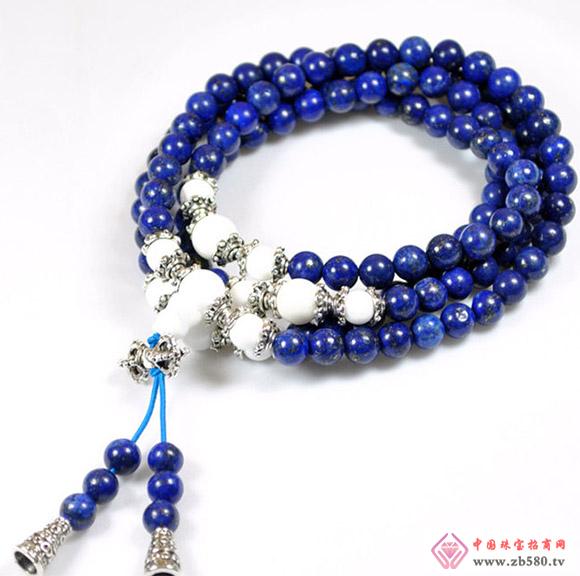The lapis lazuli (English: Lapislazuli) is a rare gems, and the blue lapis lazuli artifacts are often very precious. Lapis lazuli, also known as lapis lazuli, is a blue variant of sodalite. The lapis lazuli color is the body color of the Tibetan medicinal medicinal Buddha. It is often worn to protect the health and well-being.

Zhang Hongyi, a famous geologist in modern China, wrote in the book "Shiya" that "the color of the lapis lazuli is like the sky, or the golden swarf is scattered, and the brilliance is brilliant. If the stars are beautiful, then the ancient stone is "Tianshi" is used for the treasure of heaven. The "Qing Dian Dian Tu" said: "The emperor is facing the belt, and it is decorated with lapis lazuli for the Temple of Heaven."
The English name for lapis lazuli is LapisLazuli, from Latin LapisLazuli, the former refers to gems, and the latter refers to blue (gems). Its handicrafts are called "green gold", and ancient times it is called "Golden Bi", "Dot" or "Glass".
Main ingredient
Mainly composed of azure and calcite.
Characteristic use
1. Process characteristics The natural process properties of lapis lazuli have the following main process characteristics: (1) Absorbing rays: barium carbonate can absorb higher gamma rays and improve the refractive index of glass; (2) flux assist: cerium oxide plus The components such as carbonate, barium and calcium oxide can improve the melting property of the glass material and increase the fluidity; (3) coloring property: the nitrate of barium can emit a bright red color.
2, the main role: celestite mine is mainly used to process carbonates and nitrates into strontium, of which more than 90% are used to produce strontium carbonate. The most important use of barium carbonate is to produce fluorescent screen glass for color TV tubes because they absorb X-rays. Secondly, it is used to make special glass, and it can also be used as a lead removal agent during smelting. Niobium nitrate is a coloring agent for red pyrotechnics and signal flares. Very small amounts of antimony compounds are used in greases, ceramic glazes and pharmaceuticals.
form
The lapis lazuli is formed by contact metamorphism, mainly in the silicate-magnesium skarn and the calcareous lapis lazuli skarn. The main producing areas of lapis lazuli are the United States, Afghanistan, Mongolia, Myanmar, Chile, Canada, Pakistan, India and Angola. China has not found a lapis lazuli deposit. The lapis lazuli, whose craft name is “green goldâ€. The Persian language of the lapis lazuli is called "Large wow", Arabic and "Lasir", the Indian language is called "Ray and Wow", and the chapter is "harmony" or "glazed". Therefore, some Chinese and foreign scholars believe that the ancient Chinese "flowing glass", "sweet glass" or "glazed" refers to the lapis lazuli. However, we should also note that in ancient China, people recognized jade from the color and not on its texture. Although the color is similar, its name can still be the same, so we can't say that it is ancient. Lin or "glaze" must be lapis lazuli, as they often refer to other cyan or green jade or gems. The lapis lazuli, whose jade material is composed of lapis lazuli minerals, usually contains calcite, pyrite, and sometimes a small amount of diopside. Opaque, glass to grease luster. It has a hardness of 5.5 and a specific gravity of 2.7-2.9. Lapis lazuli has unique blue, dark blue, light blue and light cyan, etc., according to its color and can be divided into: dark gold and dark blue and thick but not black; Jingelang jujube dark blue and pyrite content More than lapis lazuli minerals; those who gave birth to the light blue and white calcite, named after the ancients used this stone as a stimulating drug. In ancient China, the burial lapis lazuli was: "With its color, this is used in the road to ascend to heaven," and it was used to make the burial of the emperor. Lapis lazuli is a traditional jade imported from China since ancient times, and most of it comes from Afghanistan. So far, the origin of the Qingjin quartz clock has not been found in China.
Jade, as a mineral, has a certain price in today's market. Usually a piece of 15 x 20mm nephrite, the price is between 6?/FONT>40 US dollars. A piece of jadeite of 15×20mm size has a great price variation depending on its color.
Lapis lanus wearing method
If the lapis lazuli is a Christian Catholic, it should be worn in the left hand. It needs to be worn according to the left and right gas field. If it is not Catholic or Christian, the left and right hands can be worn. There is no difference in the wearing effect on the left and right hands.
Ladies Flats,Ladies Flat Shoes,Womens Flat Loafers,Ladies Ballerina Shoes
Shaoxing Lucas Shoes CO.,LTD , https://www.lucascn.com